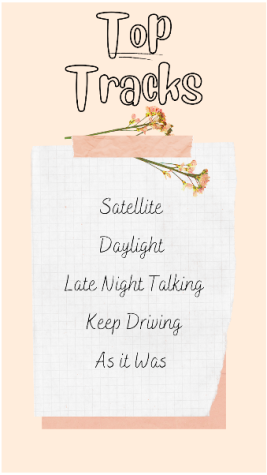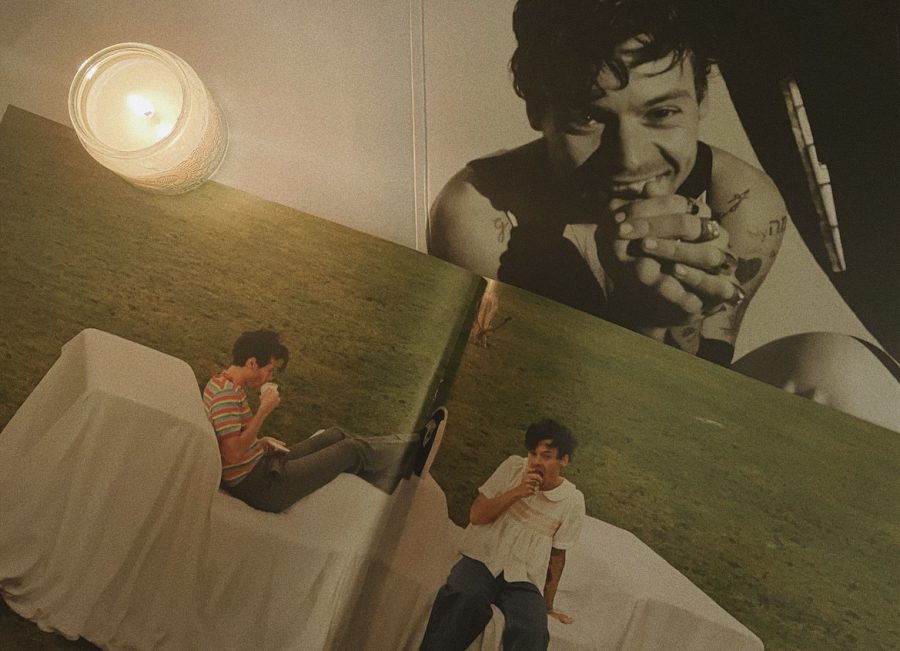‘[Harry’s House] teeters on the line between good and great’
Harry Styles’s third album “Harry’s House” was released Friday, May 20. Staff Editor Cameron Dolan shared her opinion on the album.
Harry’s third album, “Harry’s House,” has created a widespread debate as to whether it has fallen short or exceeded excellence. Compared to “Fine Line” and his debut album, “Harry’s House” greatly differs in its overall aesthetic, variation in tones, and general style. It is because of this difference that the album teeters on the line between good and great.
With 13 tracks and a new branding approach, “Harry’s House” indefinitely caught the fan base by surprise. Rather than the constant conceptually-abstract look of “Fine Line,” this new album has a softer, cottage-like aesthetic. The simplicity and mellow tone of the album originally turned me off due to the lack of intense melodies I loved from previous albums. Listeners, including myself, had grown so accustomed to Styles’ unique crescendos and choruses. Styles’ reputation of being bold and overtly eccentric had listeners expecting music that matched that same energy. Despite this initial distaste, I have learned to love the elegance that comes with unexpected simplicity.
As I adjust and sort through this album, I have come to understand that a listener’s liking of an album can also heavily depend on their current life situation. If a person is going through a rough patch, they are more inclined to enjoy a more somber album. If a person is happier, they are more likely to appreciate something upbeat. As I continue to discuss “Harry’s House” with others, I find that their feelings about the album directly correlate with their mental state.
Compared to his past albums, “Harry’s House” has a significantly smaller range of emotions in regards to his variations of tones. On Styles’ debut album, the most emotional diversity or difference in tone could be seen between “Kiwi” and “From the Dining Room Table.” “Kiwi” is an incredibly upbeat song with a hard rock feel to it. “From the Dining Room Table” is a purely somber song that speaks about the road to healing after heartbreak. In “Harry’s House,” the biggest difference in tone can be seen between “Matilda” and “Daylight” or “Daydreaming.” “Matilda,” a collection of similar melancholic tunes describing a nuclear family struggle, is arguably the saddest song on the album. “Daylight” and “Daydreaming” both are upbeat and have the most powerful crescendos in the last thirty seconds of the song. If “Harry’s House” had more emotional and musical diversity, more people would listen due to the music being applicable to a larger range of people.
The two best songs to blast during any fun occasion are “Satellite” and “Daylight.” “Satellite,” my personal favorite on the entire album, is a relatable sentiment about longing for someone from a distance. While this doesn’t sound entirely uplifting, the buildup and eventual crescendo are one of the best Styles has ever made. The use of drums and overlay of Styles’ voice distorted in multiple ways is truly a musical masterpiece. “Daylight,” another one of my favorites, starts off with a fun and loving mood. The song is all about unreciprocated love from Styles’ perceived significant other. Once again, this does not sound like a happy song, but the beats and overall melody have the same general format as “Satellite.” There is a continued buildup with joyful melodies regardless of the despairing meaning. Styles has a tendency to use this style of music in all of his albums, for it can also be seen in the song “To Be So Lonely” in “Fine Line.” Whether listeners enjoy this approach is widely disputed; however, I believe that this style is what sets Styles apart from other artists in the industry. A sophisticated touch of human emotion that is hidden behind upbeat melodies is a risk, but nonetheless, it is a risk I applaud Styles for taking.
All in all, this album is good, but not great. I would give this album a solid 8/10. As previously stated, it lacks the emotional diversity produced in previous albums. Although the expectations provoked by Styles and his reputation were very different from the reality of the album, I still believe that there are moments of excellence within certain songs. It may not be my favorite album, but it is still one I undoubtedly listen to any time I am in the mood for lighthearted indie pop music.


Cameron Dolan is a senior who joined the publication during her freshman year as a staff photographer and writer. She focuses on opinion pieces on popular...











